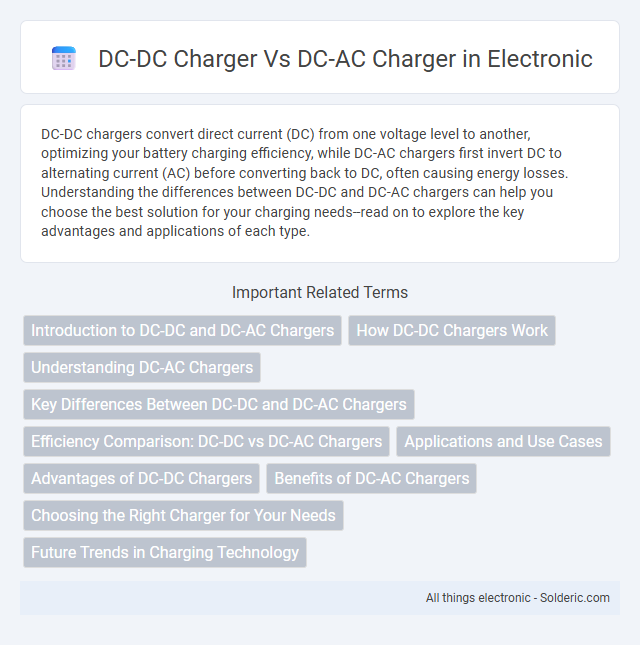DC-DC chargers convert direct current (DC) from one voltage level to another, optimizing your battery charging efficiency, while DC-AC chargers first invert DC to alternating current (AC) before converting back to DC, often causing energy losses. Understanding the differences between DC-DC and DC-AC chargers can help you choose the best solution for your charging needs--read on to explore the key advantages and applications of each type.
Comparison Table
| Feature | DC-DC Charger | DC-AC Charger |
|---|---|---|
| Conversion Type | Direct current to direct current | Direct current to alternating current |
| Efficiency | High (90-95%) | Lower (80-90%) |
| Use Case | Battery-to-battery charging | Battery to AC-powered devices or grid |
| Output Voltage | Regulated DC voltage | Standard AC voltage (e.g., 110V/220V) |
| Complexity | Less complex, smaller size | More complex, larger size |
| Cost | Generally lower | Generally higher |
| Applications | Electric vehicles, solar battery banks | Home inverters, grid tie systems |
| Heat Generation | Lower heat output | Higher heat output |
Introduction to DC-DC and DC-AC Chargers
DC-DC chargers convert direct current (DC) from one voltage level to another, optimizing battery charging efficiency in vehicles or solar systems. DC-AC chargers, also known as inverters, transform DC into alternating current (AC) suitable for powering household appliances or feeding energy back to the grid. Your choice depends on whether you need to maintain battery health with DC-DC chargers or supply AC power with DC-AC chargers.
How DC-DC Chargers Work
DC-DC chargers efficiently convert the voltage from one DC source to another, ensuring compatibility between different battery systems or power modules. They regulate voltage through high-frequency switching and transformers, optimizing energy transfer while minimizing heat loss and increasing charging speed. Your device benefits from stable and precise power delivery, making DC-DC chargers ideal for applications like solar systems and electric vehicles.
Understanding DC-AC Chargers
DC-AC chargers convert direct current (DC) from batteries or solar panels into alternating current (AC) suitable for household appliances and grid compatibility, making them essential for integrating renewable energy systems. Your choice of a DC-AC charger impacts efficiency, power output, and compatibility with various loads, requiring careful consideration of inverter types and rated capacity. Understanding these chargers involves recognizing their role in voltage regulation, waveform quality, and safety features to optimize energy use and protect connected devices.
Key Differences Between DC-DC and DC-AC Chargers
DC-DC chargers convert direct current (DC) from one voltage level to another, providing efficient power transfer for systems like automotive or solar battery management, while DC-AC chargers invert DC to alternating current (AC) suitable for household or grid use. Your choice depends on the application: DC-DC chargers excel in battery-to-battery charging scenarios, whereas DC-AC chargers enable powering AC devices or feeding energy back into the grid. These fundamental differences impact installation complexity, efficiency, and compatibility with various electrical systems.
Efficiency Comparison: DC-DC vs DC-AC Chargers
DC-DC chargers typically offer higher efficiency than DC-AC chargers because they convert voltage directly within the DC domain, minimizing energy losses associated with alternating current conversion. DC-DC chargers achieve efficiency rates often above 90%, while DC-AC chargers usually operate below 85% due to the need for additional inversion stages and complex power management. This efficiency difference makes DC-DC chargers more suitable for applications requiring optimized energy transfer and reduced heat generation.
Applications and Use Cases
DC-DC chargers are primarily used in electric and hybrid vehicles to efficiently convert voltage between battery packs, enabling optimal charging and energy management in mobile and off-grid applications. DC-AC chargers, often referred to as inverters, convert direct current power from batteries or solar panels into alternating current for household or grid-compatible devices, making them essential for residential solar energy systems and backup power solutions. The choice between DC-DC and DC-AC chargers depends on whether the system requires voltage conversion within DC circuits or power conversion to AC for end-user consumption and grid integration.
Advantages of DC-DC Chargers
DC-DC chargers offer higher efficiency by directly converting a DC power source, such as a vehicle battery, to the required voltage level without the energy losses associated with AC conversion. They provide more compact and lightweight designs, making them ideal for automotive and renewable energy applications where space and weight are critical. DC-DC chargers also enable faster and more precise charging control, improving battery lifespan and performance.
Benefits of DC-AC Chargers
DC-AC chargers convert direct current (DC) from sources like solar panels or batteries into alternating current (AC), enabling compatibility with standard household appliances and grid systems. They provide greater flexibility by supporting a wide range of electrical devices and facilitating energy feeding back into the grid. Enhanced efficiency and improved power management in DC-AC chargers contribute to optimized energy utilization and system reliability.
Choosing the Right Charger for Your Needs
DC-DC chargers efficiently convert voltage from a vehicle's battery to charge auxiliary batteries, ideal for maintaining power in off-grid setups and RV systems. DC-AC chargers, also known as inverters, convert direct current (DC) to alternating current (AC), enabling the use of household appliances and electronics from a battery source. Selecting the right charger depends on the power source compatibility, the type of devices being powered, and the specific voltage and current requirements of the battery system.
Future Trends in Charging Technology
DC-DC chargers offer higher efficiency and faster charging capabilities compared to DC-AC chargers, making them increasingly suitable for electric vehicle applications and renewable energy integration. Future trends emphasize solid-state components and smart charging algorithms to optimize energy transfer, minimize losses, and enable seamless vehicle-to-grid interactions. Your adoption of advanced DC-DC technology can enhance charging speed, reduce energy costs, and support sustainable energy ecosystems.
DC-DC charger vs DC-AC charger Infographic

 solderic.com
solderic.com